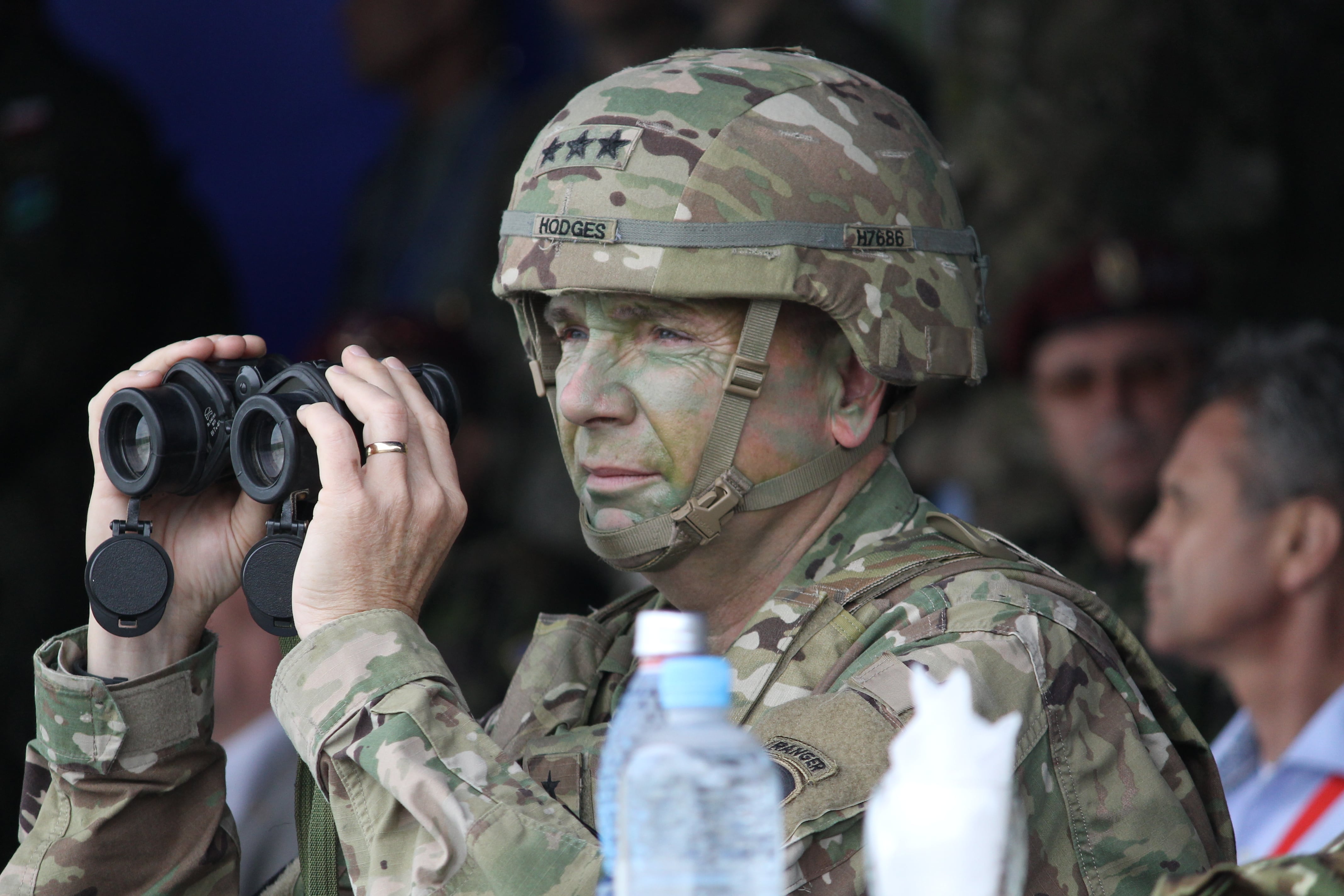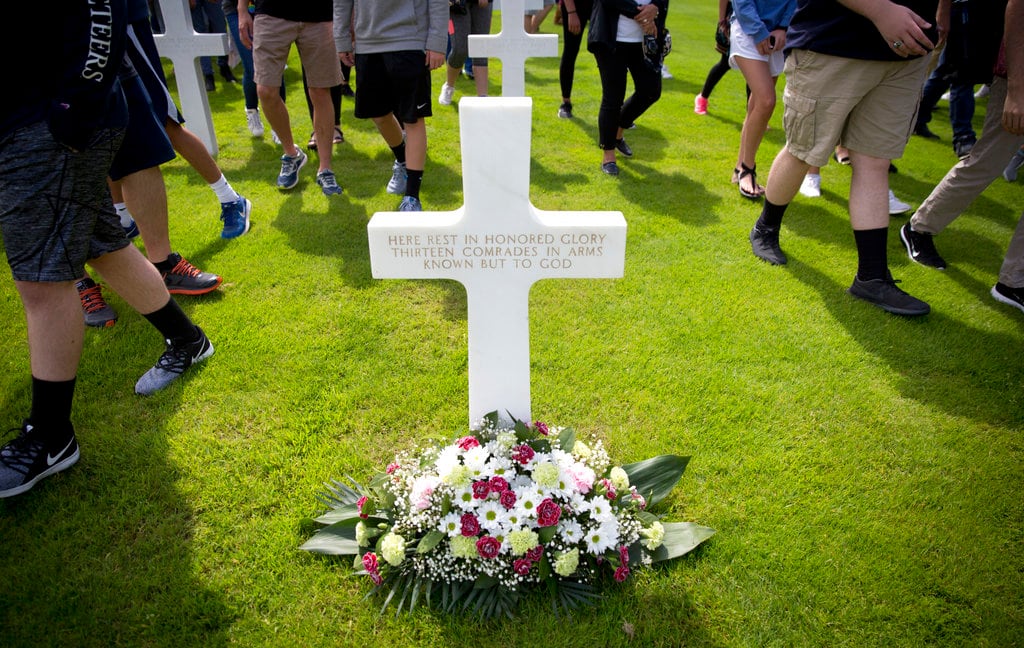CINCU, Romania – As the U.S. Army Europe commander prepares to exit the military stage in September, he’s pushing for better ways for militaries to move freely around the European theater. A military Schengen zone, he thinks, might be the best way to achieve that goal.
In addition to improving the speed at which countries recognize an emerging crisis and make decisions on how to respond, the “speed of assembly,” is also critical to get capability in place to prevent a crisis or react to a crisis, Lt. Gen. Ben Hodges said at the U.S. Army-led Saber Guardian exercise in Romania this month.
“This exercise has helped us improve our speed of assembly, the movement of allied forces from all over Europe to the Black Sea region and highlighted that we still have challenges with freedom of movement,” he said.
“More than anything we need a military Schengen zone, something that would allow a military convoy to move across Europe as fast as a migrant is able to move across Europe,” Hodges said. “Right now that is not the case.”
The Schengen zone in Europe is made up of 26 countries that allow Europeans to travel without a passport between the participating countries, essentially treating the territory as one single country for travel purposes.
Hodges explained a Schengen zone for the military would give political leaders a lot more flexibility, “if on very short notice they could move an armored brigade,” for example, to send a message to the aggressor not to proceed.
Since beginning heel-to-toe rotational deployments of armored brigade combat teams and combat aviation brigades in Europe this January, the U.S. Army has made progress practicing rapidly massing equipment and troops in countries near the Russian border as it works to deter Russian aggression in the region.
[Deterring Russia: US Army hones skills to mass equipment, troops in Europe]
For Saber Guardian, the Army moved the majority of its rotational ABCT quickly from Poland and other countries into Romania bringing its M1 Abrams tanks, Bradley Fighting Vehicles and Paladin Howitzers with it.
[US Army's first heavy brigade rotation in Europe learns newfound agility]
But even though the process of moving troops and heavy equipment across borders has improved, there is still much room for improvement.
While flying with Defense News in his UH-60 Black Hawk from Bezmer Air Base, Bulgaria, to Capu Midia, Romania, in the midst of hopping from one exercise to another during Saber Guardian, Hodges was informed that his helicopter would have to make a pit stop out of the way at M.K. Air Base in Romania in order to clear customs.
A customs check at M.K. Air Base would have delayed the commander by roughly an hour and with his tight schedule he likely would have missed the start of a short-range air defense system live-fire exercise on the Black Sea.
Hodges wasn’t happy with the lack of flexibility to move as a military official from one participating country to another during a major U.S.-led military exercise.
A few emails and phone calls later and the stop-over was diverted. Hodges made it on time to the exercise at Capu Midia, but the experience was a good example of the commonly encountered red tape the military must work through on a regular basis to keep operations moving smoothly.
Hodges said he has seen some progress in terms of considering a military Schengen zone, noting the defense minister of the Netherlands recently submitted a proposal inside the European Union that would create such a zone.
On his prior approach, which was to advocate through NATO channels, Hodges said, “I was probably pursuing the wrong path in the beginning and the EU was probably where I should have started because I think they have mechanisms that may be more appropriate.”
NATO is also beginning to see the utility of such an arrangement as well. Hodges noted NATO Secretary General Jens Stoltenberg has “talked about the importance of this as well.”
How simple or challenging setting up a military Schengen zone might be remains to be seen.
“I think it’s actually a relatively simple thing to do to create an agreement that is simple and fairly limited in scope,” Hodges told Defense News in a one-on-one interview at Bezmer Air Base in Bulgaria the morning after 13 military aircraft dropped hundreds of paratroopers there, a feat in itself in terms of practicing airborne customs clearance.
The aircraft received in-air clearances after taking off from Hungary and flying over Romania and Bulgaria.
“If the leadership of the countries, whether it’s of the European Union or the alliance, understand it, then it actually shouldn’t be that hard to start making immediate improvements,” Hodges said. “Poland has already done things internally. Lithuania and Latvia have done things internally. Others will be reluctant.”
Yet setting up a military Schengen zone is still a big ask when it comes to having to change laws and regulations within countries to allow freedom of movement.
“We would all have to earn the confidence of each nation that clearly we have to obey EU road laws and regulations, that we have to respect sovereignty,” he said. For example, “you can’t just go driving in the U.S., you could not take a tanker full of liquefied gas and drive from one state to another unless you had the markings. I don’t expect anything less restrictive than that.”
When countries talk about making contributions in order to meet the NATO commitment of spending 2 percent of a country’s GDP on defense, Hodges has said investment in infrastructure like rail lines and cars would be a good way to meet it and would help rapid movement of troops and equipment in a crisis.
[US Army Europe chief: NATO allies should bolster infrastructure]
For a military Schengen zone to become reality, it’s going to take the countries that would most likely be on the receiving end of help from the alliance – the Baltic States and others in close proximity to Russia – “hammering on the door saying, ‘Hey, we have to be able to do this,’” Hodges said.
“There will be less urgency [from] allies sending units if you will,” Hodges said. “It needs to be more than just U.S. Army Europe clamoring for this improved freedom of movement.”
Jen Judson is an award-winning journalist covering land warfare for Defense News. She has also worked for Politico and Inside Defense. She holds a Master of Science degree in journalism from Boston University and a Bachelor of Arts degree from Kenyon College.





